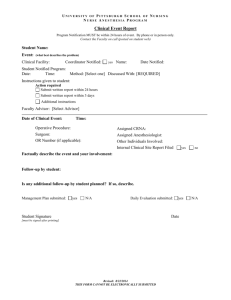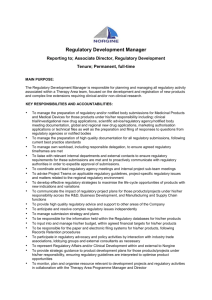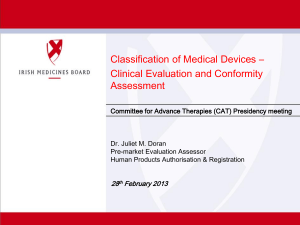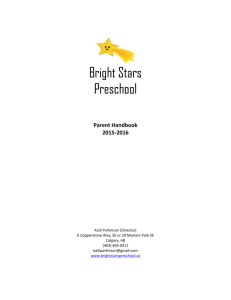Full Public Report
advertisement
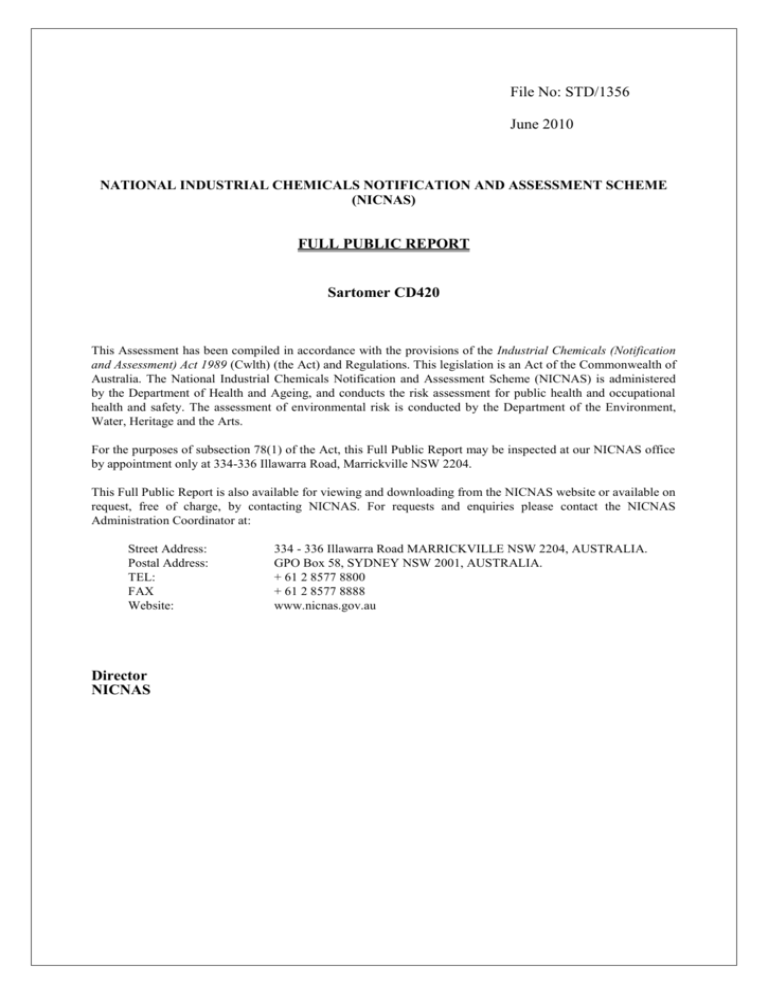
File No: STD/1356 June 2010 NATIONAL INDUSTRIAL CHEMICALS NOTIFICATION AND ASSESSMENT SCHEME (NICNAS) FULL PUBLIC REPORT Sartomer CD420 This Assessment has been compiled in accordance with the provisions of the Industrial Chemicals (Notification and Assessment) Act 1989 (Cwlth) (the Act) and Regulations. This legislation is an Act of the Commonwealth of Australia. The National Industrial Chemicals Notification and Assessment Scheme (NICNAS) is administered by the Department of Health and Ageing, and conducts the risk assessment for public health and occupational health and safety. The assessment of environmental risk is conducted by the Department of the Environment, Water, Heritage and the Arts. For the purposes of subsection 78(1) of the Act, this Full Public Report may be inspected at our NICNAS office by appointment only at 334-336 Illawarra Road, Marrickville NSW 2204. This Full Public Report is also available for viewing and downloading from the NICNAS website or available on request, free of charge, by contacting NICNAS. For requests and enquiries please contact the NICNAS Administration Coordinator at: Street Address: Postal Address: TEL: FAX Website: Director NICNAS 334 - 336 Illawarra Road MARRICKVILLE NSW 2204, AUSTRALIA. GPO Box 58, SYDNEY NSW 2001, AUSTRALIA. + 61 2 8577 8800 + 61 2 8577 8888 www.nicnas.gov.au TABLE OF CONTENTS FULL PUBLIC REPORT.............................................................................................................................................. 3 1. APPLICANT AND NOTIFICATION DETAILS .................................................................................... 3 2. IDENTITY OF CHEMICAL ................................................................................................................... 3 3. COMPOSITION....................................................................................................................................... 4 4. PHYSICAL AND CHEMICAL PROPERTIES ....................................................................................... 4 5. INTRODUCTION AND USE INFORMATION ..................................................................................... 4 6. HUMAN HEALTH IMPLICATIONS ..................................................................................................... 5 7. ENVIRONMENTAL IMPLICATIONS .................................................................................................. 8 8. CONCLUSIONS AND REGULATORY OBLIGATIONS ................................................................... 10 APPENDIX A: PHYSICAL AND CHEMICAL PROPERTIES ........................................................................................... 13 APPENDIX C: ENVIRONMENTAL FATE AND ECOTOXICOLOGICAL INVESTIGATIONS ............................................... 14 BIBLIOGRAPHY ...................................................................................................................................................... 19 June 2010 NICNAS FULL PUBLIC REPORT Sartomer CD420 1. APPLICANT AND NOTIFICATION DETAILS APPLICANTS Hewlett Packard (ABN: 74 004 394 763) 353 Burwood Highway, Forest Hill, VIC 3131 AND CPI GRAPHICS (ABN: 54 004 081 501) 41-45 Mills Road Breaside, VIC 3195 AND INTERNATIONAL SALES AND MARKETING (ABN: 36 467 259 314 ) 260-262 Highett Road Highett, VIC 3190 NOTIFICATION CATEGORY Standard: Chemical other than polymer (more than 1 tonne per year). EXEMPT INFORMATION (SECTION 75 OF THE ACT) Data items and details claimed exempt from publication: chemical name, other names, CAS number, molecular and structural formulae, molecular weight, spectral data, purity, identity and % weight of toxic or hazardous impurities/non-hazardous impurities and identity and % weight of additives/adjuvants. VARIATION OF DATA REQUIREMENTS (SECTION 24 OF THE ACT) Variation to the schedule of data requirements is claimed as follows: PHYSICAL CHEMICAL PROPERTIES Boiling point, Vapour pressure, Water solubility, Partition coefficient, Dissociation constant, Flash point and Flammability limits. TOXICITY Acute oral toxicity, Acute dermal Toxicity, Acute Inhalation Toxicity, Skin Irritation, Eye Irritation, Skin Sensitisation, Repeated Dose Toxicity, Induction of Point Mutations, Induction of Germ Cell Damage, and Chromosome Damage. ECOTOXICITY Fish, Acute Toxicity; Daphnia sp., Acute Immobilisation/Reproduction; Algal growth inhibition; Bioaccumulation and Biodegradation. PREVIOUS NOTIFICATION IN AUSTRALIA BY APPLICANT(S) CEC Permit No 728, CEC Permit No 746 NOTIFICATION IN OTHER COUNTRIES None 2. IDENTITY OF CHEMICAL MARKETING NAME(S) Sartomer CD 420 SR 420 FULL PUBLIC REPORT: STD/1356 Page 3 of 19 June 2010 3. COMPOSITION DEGREE OF PURITY 4. NICNAS >95% PHYSICAL AND CHEMICAL PROPERTIES APPEARANCE AT 20ºC AND 101.3 kPa: Liquid Property Boiling Point Density Vapour Pressure Water Solubility Hydrolysis as a Function of pH Value 234.38 ± 9.00oC at 101.3 kPa 930 kg/m3 at 25oC 8.24 10-3 kPa at 25oC 1.0 10-2 g/L Not determined Partition Coefficient (n-octanol/water) Adsorption/Desorption Dissociation Constant Particle Size Flash Point Flammability log Pow = 4.29 Autoignition Temperature Explosive Properties log Koc = 2.65 and 3.23 Not determined N/A 86oC at 101.3 kPa Upper: 0.9 % Lower: 5.0 % 93oC No explosive properties Data Source/Justification Calculated by ACD I-Lab Service. MSDS Calculated Calculated Not expected to hydrolyse environmental pH (4-9) Calculated at Calculated No dissociable functions The notified chemical is in liquid form Analogue 1 data Analogue 1 data MSDS Based on its structural information, the notified chemical is not expected to be explosive. DISCUSSION OF PROPERTIES For full details of tests on physical and chemical properties, refer to Appendix A. Reactivity The notified chemical is intended to react in use. It is not stable in the presence of strong oxidizers, strong reducers, free radical initiators, inert gases, oxygen scavengers. Hazardous polymerisation may occur on depletion of inhibitor. Conditions to avoid: high temperatures, localized heat sources, oxidizing conditions, freezing conditions, direct sunlight, ultraviolet radiation, inert gas blanketing. Dangerous Goods classification Based on the physical-chemical data provided in the above table the notified chemical cannot be classified according to the Australian Dangerous Goods Code (NTC, 2007). However the data above does not address all Dangerous Goods endpoints. Therefore consideration of all endpoints should be undertaken before a final decision on the Dangerous Goods classification is made by the introducer of the chemical. The close analogue 1 is classed as combustible liquid according to the National Fire Protection Association (NFPA) and giving a flammability rating of 2, while analogue 2 is classified as Flammable liquid. According to the reactivity of the notified chemical and the flammability of the close analogue the notified chemical requires Storage in accordance with the National Standard for the Storage and Handling of Workplace Dangerous Goods [NOHSC:1015(2001)] for C1 combustible liquids. 5. INTRODUCTION AND USE INFORMATION MODE OF INTRODUCTION OF NOTIFIED CHEMICAL (100%) OVER NEXT 5 YEARS The notified chemical will be imported as a component of inkjet printing inks in 5L plastic bottles at a concentration of up to 30%. MAXIMUM INTRODUCTION VOLUME OF NOTIFIED CHEMICAL (100%) OVER NEXT 5 YEARS FULL PUBLIC REPORT: STD/1356 Page 4 of 19 June 2010 Year Tonnes NICNAS 1 <10 2 <10 3 <10 4 <10 5 <10 PORT OF ENTRY SYDNEY AND MELBOURNE. IDENTITY OF RECIPIENTS CPI Graphics, Hewlett-Packard Australia Pty Ltd and International Sales & Marketing Pty Ltd TRANSPORTATION AND PACKAGING The notified chemical will be imported in 5L plastic bottles at a concentration of up to 30%. It will be transported from port of entry to the notifier’s warehouse facilities or directly to the customers (printing industries). USE The notified chemical is intended for use as a UV curing agent in inks. It will be imported as a component of formulated inkjet printing inks at up to 30% concentration. The formulated inks will be used by industrial printers for digital printing of large format images such as posters, banners etc. OPERATION DESCRIPTION The notified chemical will not be manufactured, reformulated or repackaged in Australia. The inks containing the notified chemical at up to 30% will be used in industrial printers for the digital printing of large format images on a variety of substrates. The ink bottles will be manually connected to the printing machines via an inlet and attached to a flexible tube which supplies the ink head. Ink will be automatically injected into printing machines. While printers are running, printer operators monitor the operation, keep the substrate feeders stocked, attend to substrate jams, and will carry out the quality control work as required. After printing, the notified chemical will be fixed (UV-cured) with other ink ingredients into the substrate matrix. Any residual ink within printing equipment will be wiped clean using rags and solvents. Printer operators wear gloves during these tasks. Rags and dirty solvents are normally disposed of by the printing company through licensed waste disposal contractors. 6. HUMAN HEALTH IMPLICATIONS 6.1 Exposure assessment 6.1.1 Occupational exposure NUMBER AND CATEGORY OF WORKERS Category of Worker Number Transport and storages Service technicians Printer operators Wholesale printer supplies 10-20 200 > 1000 > 1000 Exposure Duration (hours/day) 4-8 0.5 8 8 Exposure Frequency (days/year) 200 5 200 200 EXPOSURE DETAILS Dermal exposure of transport, warehousing and wholesale workers to the imported notified chemical will occur only in the event of an accident where the packaging is breached. The most likely route of exposure of service technicians is dermal as they will come in contact with the notified chemical during printer maintenance. Inhalation exposure is unlikely due to the low vapour pressure of the FULL PUBLIC REPORT: STD/1356 Page 5 of 19 June 2010 NICNAS notified chemical (8.24 10-3 kPa). Printer maintenance personnel will wear disposable gloves and safety glasses. Printer operators will have limited exposure to the notified chemical, as the process is mainly automated. Dermal and ocular exposure is possible during the replacement of ink bottles (manual process) and cleaning residual ink from printers. Inhalation exposure will be limited due to the low vapour pressure of the notified substance and because of local exhaust ventilation employed in areas surrounding printing machines. After application to the substrate, the ink containing the notified chemical is UV-cured (chemically reacted) and hence the notified chemical will not be bioavailable. 6.1.2. Public exposure The printer inks containing the notified chemical will not be sold to the public. After application to the substrate and cured, the notified chemical is expected to remain bound to the substrate print matrix and will not be available for exposure. 6.2. Human health effects assessment No toxicity data were submitted for the notified chemical. Toxicity information on some analogue chemicals were submitted. The analogue data are summarised in the table below. FULL PUBLIC REPORT: STD/1356 Page 6 of 19 June 2010 NICNAS Endpoint Rat, acute oral toxicity Rat, acute dermal toxicity Rat, acute inhalation toxicity Rabbit, skin irritation Rabbit, eye irritation Guinea pig, skin sensitisation Mouse, skin sensitisation – Local lymph node assay Rat, repeat dose <Inhalation> toxicity – 90 days. Mutagenicity – bacterial reverse mutation Genotoxicity – in vitro <Mammalian Chromosomal Aberration test> Genotoxicity – in vivo <in vivo cytogenetic assayclastogenicity> Carcinogenicity Analogue 1* LD50 >5000 mg/kg bw; low toxicity LD50 > 7500 mg/kg bw; low toxicity LC50 >1.4 mg/L/8 hour; Analogue 2 LD50 >3000 mg/kg bw; low toxicity LD50 > 1500 mg/kg bw; low toxicity LC50 >10.3 mg/L/4 hour; Result and Conclusion Analogue 3 LD50 >9000 mg/kg bw; low toxicity LD50 >5000 mg/kg bw; low toxicity LC50 >30 mg/L/4 hour; severely irritating irritating evidence of sensitisation Not available Not available Not available moderate irritating moderate irritating evidence of sensitisation evidence of sensitisation weak sensitiser NOAEL = 23 mg/kg bw/day. LOAEL = 0.225 mg/L (68 mg/kg bw/day) Analogue 4 LD50 >5000 mg/kg bw; low toxicity LD50 > 5000 mg/kg bw; low toxicity Not available Analogue 5* LD50 >8000 mg/kg bw; low toxicity LD50 > 2500 mg/kg bw; low toxicity Not available Not available Not available evidence of sensitisation evidence of sensitisation slightly irritating slightly irritating no evidence of sensitisation Not available NOAEL = 84 (male) and 111 (female) mg/kg bw/day Not available Not available Not available non mutagenic non mutagenic non mutagenic non mutagenic non genotoxic Not available Not available Not available Not available non genotoxic Not available Not available Not available Not available no evidence of carcinogenicty no evidence of carcinogenicty no evidence of carcinogenicty evidence of carcinogenicity through dermal route (>21%) * Closely resembles the notified chemical FULL PUBLIC REPORT: STD/1356 Page 7 of 19 Not available June 2010 NICNAS Health hazard classification Based on the analogue data provided, the notified chemical is classified as hazardous according to the Approved Criteria for Classifying Hazardous Substances (NOHSC, 2004) with the following risk phrases: Xi; R36/38: Irritating to eyes and skin. R43: May cause sensitisation by skin contact. 6.3. Human health risk characterisation 6.3.1. Occupational health and safety The notified chemical has not been tested for any toxicological properties but based on analogue data, it is likely to be a skin and eye irritant and a skin sensitiser. These hazards are expected during handling of ink products containing up to 30% of the notified chemical, particularly during manual replacement of ink containers, cleaning of ink residuals and servicing the printing machine. All printing operations involving the notified chemical should take place under local exhaust ventilation. Printer operators and servicing personnel should wear PPE to minimise skin and eye exposure during handling the ink products containing the notified chemical at up to 30%. Overall the risk to workers can be considered acceptable if above controls are in place. 6.3.2. Public health The inks containing the notified chemical at up to 30% will not be sold to the public. No exposure is expected from the dried printed materials. Therefore, risk to the public from the notified chemical is not expected. 7. ENVIRONMENTAL IMPLICATIONS 7.1. Environmental Exposure & Fate Assessment 7.1.1 Environmental Exposure RELEASE OF CHEMICAL AT SITE The notified chemical will be imported into Australia as a component of a final product in ready-to-use 5 L ink bottles. No manufacturing and reformulation of the notified chemical will take place in Australia. Environmental release of the notified chemical is unlikely to occur during importation, storage and transportation. RELEASE OF CHEMICAL FROM USE The ready-to-use 5 L ink bottles will be designed to prevent leakage and will not be opened during transport, use, installation or replacement. Therefore, release of toner containing the notified chemical to the environment is not expected under normal conditions of use. If leakage or spillage does occur, the toner will be physically contained with absorbent material and disposed of to landfill. 5 L ink bottles will be contained within the printer until the contents are consumed and then they will be removed and sent for recycling or disposed of to landfill. Approximately 0.1% of the ink containing the notified chemical will remain in spent 5 L ink bottles. RELEASE OF CHEMICAL FROM DISPOSAL The majority of the notified chemical is expected to be disposed of to landfill and is expected to remain associated with the substrates (e.g. plastic and paper) to which it has been applied. Of the 5% notified chemical applied to paper, half of this amount is expected to be recycled. During recycling processes, waste paper is repulped using a variety of chemical agents which, amongst other things, enhance detachment of ink from the fibres. FULL PUBLIC REPORT: STD/1356 Page 8 of 19 June 2010 7.1.2 NICNAS Environmental fate Due to its high volatility, the notified chemical’s potential for persistence in air and long range transport was assessed using “AOP Program (v1.92)”. This estimates the half-life of the notified chemical in air, based on a 12 hour day, as being 5.9 h, which indicates that the notified chemical is expected to react rapidly with OH-radicals and therefore will not have the potential for long-range transport. Based on results of a biodegradation study of an analogue of the notified chemical, provided with this notification, the notified chemical is expected to be readily biodegradable and therefore not expected to persist in the environment. The notified chemical is not anticipated to bioaccumulate since it is expected to be readily biodegradable. The fraction of the notified chemical applied to paper will be cured and is not expected to be bioavailable. For details of the environmental fate studies refer to Appendix C. 7.1.3 Predicted Environmental Concentration (PEC) PECs (ocean and river) have been calculated assuming that 5% of the total imported notified chemical will be applied to paper and half of this amount will be recycled. A worst case continental model has been assumed in which none of the notified chemical entering waste water treatment plants is removed from the effluents. It is expected the PECs will be less than the calculated values since most of the notified chemical will be adsorbed to sediment due to its hydrophobicity. Predicted Environmental Concentration (PEC) for the Aquatic Compartment Total Annual Import/Manufactured Volume Proportion expected to be released to sewer Annual quantity of chemical released to sewer Days per year where release occurs Daily chemical release: Water use Population of Australia (Millions) Removal within STP Daily effluent production: Dilution Factor - River Dilution Factor - Ocean PEC - River: PEC - Ocean: 7.2. 10,000 2.5% 250 365 0.68 200 21.161 0% 4,232 1.0 10.0 0.16 0.02 kg/year kg/year days/year kg/day L/person/day million ML μg/L μg/L Environmental effects assessment The results from ecotoxicological investigations conducted on an analogue (different to ones provided for health end points) of the notified chemical are summarised in the table below. Details of these studies can be found in Appendix C. Endpoint Fish Toxicity Daphnia Toxicity – Acute Daphnia Toxicity – Chronic (reproduction) Algal Toxicity Result LC50 (96 h) = 0.67 mg/L EC50 (48 h) = 0.40 mg/L Assessment Conclusion Very toxic to fish Very toxic to aquatic invertebrates Study 1: LOEC (21 d) = 0.13 mg/ L NOEC (21 d) < 0.13 mg/L At least harmful to aquatic invertebrates with long lasting effects Study 2: NOEC (14 d) = 0.51 mg/L Harmful to aquatic invertebrates with long lasting effects Toxic to algae ErC50 (96 h) = 2.13 mg/L NOEC (96 h) = 1.70 mg/L FULL PUBLIC REPORT: STD/1356 Page 9 of 19 June 2010 NICNAS Under the Globally Harmonised System of Classification and Labelling of Chemicals (United Nations, 2009) the notified chemical is acutely toxic to algae, acutely very toxic to fish and aquatic invertebrates. As there were incomplete data for the chronic endpoints for all three trophic levels of the analogue of the notified chemical, the most stringent classification for the long term effects of the analogue of the notified chemical was applied and this was based on the most sensitive acute endpoint and the log Pow. Therefore the notified chemical is classified very toxic to aquatic invertebrates with long lasting effects. 7.2.1 Predicted No-Effect Concentration The lowest endpoint from ecotoxicological studies of an analogue to the notified chemical was used to calculate the PNEC. An assessment factor of 500 was used since ecotoxicity results for three acute trophic endpoints and one chronic endpoint were available for an analogue chemical which had minor structural differences to the notified chemical. Predicted No-Effect Concentration (PNEC) for the Aquatic Compartment NOEC (Daphnia Chronic) Assessment Factor PNEC: < 0.13 500 < 0.26 mg/L μg/L 7.3. Environmental risk assessment The risk quotients (Q = PEC/PNEC) are tabulated below. PEC μg/L < 0.16 < 0.02 Risk Assessment Q - River Q - Ocean PNEC μg/L < 0.26 < 0.26 Q 0.622 0.062 The risk quotient for aquatic exposure is calculated to be < 1 based on the above calculated PEC and PNEC values and is an upper limit based on the expectation that most of the notified chemical will be adsorbed to sludge and sediment in STPs. The Q value of < 1 indicates the notified chemical is not expected to pose an unacceptable risk to the aquatic environment from its proposed use pattern. 8. CONCLUSIONS AND REGULATORY OBLIGATIONS Hazard classification Based on the analogue data provided, the notified chemical is classified as hazardous according to the Approved Criteria for Classifying Hazardous Substances (NOHSC, 2004) with the following risk phrases: Xi; R36/38: Irritating to eyes and skin. R43: May cause sensitisation by skin contact. and As a comparison only, the classification of the notified chemical using the Globally Harmonised System for the Classification and Labelling of Chemicals (GHS) (United Nations 2009) is presented below. This system is not mandated in Australia and carries no legal status but is presented for information purposes. Hazard category Hazard statement Eye irritation 2 Causes eye irritation Skin irritation 2 Causes skin irritation Skin sensitisation 1A May cause sensitisation by skin contact Aquatic toxicity Acute category 1 Very toxic to aquatic life Chronic category 1 Very toxic to aquatic life with long lasting effects FULL PUBLIC REPORT: STD/1356 Page 10 of 19 June 2010 NICNAS Human health risk assessment Under the conditions of the occupational settings described, the notified chemical is not considered to pose an unacceptable risk to the health of workers. When used in the proposed manner, the notified chemical is not considered to pose an unacceptable risk to public health. Environmental risk assessment On the basis of the PEC/PNEC ratio and the reported use pattern, the notified chemical is not expected to pose a risk to the environment. Recommendations REGULATORY CONTROLS Hazard Classification and Labelling Safe Work Australia should consider the following health hazard classification for the notified chemical: R36/38: Irritating to eyes and skin R43: May cause sensitisation by skin contact. The following risk phrases are recommended in the workplace on products/mixtures containing the notified chemicals: Concentration 20% : R36/R38, R43 1% Concentration < 20% : R43 Health Surveillance As the notified chemical presents a skin sensitisation health hazard, employers should carry out health surveillance for any worker who has been identified in the workplace risk assessment as having a significant risk of sensitisation. CONTROL MEASURES Occupational Health and Safety Employers should implement the following engineering controls to minimise occupational exposure to the notified chemical: Local exhaust ventilation should be in place during all operations involving handling of the notified chemical. Employers should implement the following safe work practices to minimise occupational exposure during handling of the notified chemical: Avoid contact with eyes and skin. Employers should ensure that the following personal protective equipment is used by workers to minimise occupational exposure to the notified chemical during handling of ink products containing up to 30% of the notified chemical, particularly during manual replacement of ink containers, cleaning of ink residuals and servicing the printing machine: Gloves. Safety glasses. Protective clothing. Guidance in selection of personal protective equipment can be obtained from Australian, Australian/New Zealand or other approved standards. A copy of the MSDS should be easily accessible to employees. FULL PUBLIC REPORT: STD/1356 Page 11 of 19 June 2010 NICNAS If products and mixtures containing the notified chemical are classified as hazardous to health in accordance with the Approved Criteria for Classifying Hazardous Substances [NOHSC:1008(2004)], workplace practices and control procedures consistent with provisions of State and Territory hazardous substances legislation must be in operation. Disposal The notified chemical should be disposed of to landfill. Storage The following precautions should be taken regarding storage of the notified chemical: Storage in accordance with the National Standard for the Storage and Handling of Workplace Dangerous Goods [NOHSC:1015(2001)] for C1 combustible liquids. Emergency procedures Spills or accidental release of the notified chemical should be handled by physical containment, collection and subsequent safe disposal. Regulatory Obligations Secondary Notification This risk assessment is based on the information available at the time of notification. The Director may call for the reassessment of the chemical under secondary notification provisions based on changes in certain circumstances. Under Section 64 of the Industrial Chemicals (Notification and Assessment) Act (1989) the notifier, as well as any other importer or manufacturer of the notified chemical, have post-assessment regulatory obligations to notify NICNAS when any of these circumstances change. These obligations apply even when the notified chemical is listed on the Australian Inventory of Chemical Substances (AICS). Therefore, the Director of NICNAS must be notified in writing within 28 days by the notifier, other importer or manufacturer: (1) Under Section 64(2) of the Act; if the function or use of the chemical has changed from inkjet printing ink use up to 30%, or is likely to change significantly; the amount of chemical being introduced has increased from 10 tonnes, or is likely to increase, significantly; the chemical has begun to be manufactured in Australia; additional information has become available to the person as to an adverse effect of the chemical on occupational health and safety, public health, or the environment. The Director will then decide whether a reassessment (i.e. a secondary notification and assessment) is required. No additional secondary notification conditions are stipulated. Material Safety Data Sheet The MSDS of products containing the notified chemical provided by the notifier were reviewed by NICNAS. The accuracy of the information on the MSDS remains the responsibility of the applicant. FULL PUBLIC REPORT: STD/1356 Page 12 of 19 June 2010 NICNAS APPENDIX A: PHYSICAL AND CHEMICAL PROPERTIES 8.24 10-3 kPa at 25oC Vapour Pressure Method Remarks Test Facility MPBVP (v1.43) EPI Suite 4.00 US EPA (2009) 1.0 10-2 g/L Water Solubility Method Remarks Test Facility WSKOW (v1.41) EPI Suite 4.00 US EPA (2009) Partition Coefficient (noctanol/water) Method Remarks Test Facility KOWWIN (v1.67) EPI Suite 4.00 US EPA (2009) Adsorption/Desorption – screening test Method Remarks Test Facility log Pow = 4.29 log Koc = 2.65 and 3.23 KOCWIN (v2.00) Calculated from MCI (Molecular Connectivity Index) and Log Pow respectively. EPI Suite 4.00. US EPA (2009) FULL PUBLIC REPORT: STD/1356 Page 13 of 19 June 2010 NICNAS APPENDIX C: ENVIRONMENTAL FATE AND ECOTOXICOLOGICAL INVESTIGATIONS C.1. Environmental Fate C.1.1. Ready biodegradability TEST SUBSTANCE Analogue of the notified chemical METHOD OECD TG 301 D Ready Biodegradability: Closed Bottle Test. Inoculum Exposure Period Auxiliary Solvent Analytical Monitoring Remarks - Method Unknown 28 days Unknown Unknown The analysis of this study is based on summary information presented in a reliable internationally peer reviewed data set for an analogue of the notified chemical. RESULTS Day 5 15 28 Test substance % Degradation 72 100 100 Remarks - Results Day 5 15 28 Sodium Benzoate % Degradation 56 74 >83 The reference substance was degraded >60% by day 14, indicating a valid test. Since the raw data were not available, it was not possible to determine if the other validity criteria were satisfied. However, the authors of the summary considered the study to be valid without restriction and we therefore consider that the test was valid. CONCLUSION The test substance, and by inference the notified chemical, is considered to be readily biodegradable TEST FACILITY Exempt Information C.2. Ecotoxicological Investigations C.2.1. Acute toxicity to fish TEST SUBSTANCE Analogue of the notified chemical METHOD OECD TG 203 Fish, Acute Toxicity Test – Flow Through Species Exposure Period Auxiliary Solvent Water Hardness Analytical Monitoring Remarks – Method Pimephales promelas (fathead minnow) 96 hours None 186-187 mg CaCO3/L GC/MS The analysis of this study is based on summary information presented in a reliable internationally peer reviewed data set for an analogue of the notified chemical. Standard protocol guidelines were followed with no significant deviations reported. The LC50 and NOEC were determined using the trimmed Spearman-Karber method and TOXSTAT, respectively. RESULTS FULL PUBLIC REPORT: STD/1356 Page 14 of 19 June 2010 NICNAS Concentration mg/L Nominal Mean Measured 0 NC 0.35 0.09 0.62 0.15 1.12 0.34 2.01 0.82 3.45 1.75 Number of Fish 3h 6h 24 h 20 20 20 20 20 20 0 0 0 0 0 0 0 0 0 0 0 0 0 0 0 0 0 1 Mortality 48 h 72 h 96 h 0 0 0 1 13 20 0 0 0 1 13 20 0 0 0 1 7 20 NC = not calculated. All measurements of the control sample were <0.04 mg/L, which was the detection limit of the analytical method. LC50 NOEC Remarks – Results 0.67 mg/L at 96 hours (based on mean measured test concentrations) 0.34 mg/L at 96 hours (based on mean measured test concentrations) All validation criteria for the study were satisfied except that the mean measured concentrations of the test substance were 26-50% of the nominal concentrations. The measured concentrations should preferably be at least 80% of the nominal concentrations. In accordance with test guidelines, the measured concentrations were used to determine the study endpoints. CONCLUSION The test substance, and by inference the notified chemical, is considered to be very toxic to fish TEST FACILITY Exempt Information C.2.2. Acute toxicity to aquatic invertebrates TEST SUBSTANCE Analogue of the notified chemical METHOD OECD TG 202 Daphnia sp. Acute Immobilisation Test and Reproduction Test - Static Daphnia magna 48 hours None 193 - 197 mg CaCO3/L Conducted with an unknown method The analysis of this study is based on summary information presented in a reliable internationally peer reviewed data set for an analogue of the notified chemical. Standard protocol guidelines were followed with no significant deviations reported. Species Exposure Period Auxiliary Solvent Water Hardness Analytical Monitoring Remarks - Method RESULTS Concentration mg/L Nominal Actual* 0 0.5 1.0 2.0 4.0 8.0 Number of D. magna <0.04 0.24 0.53 1.21 2.78 7.40 20 20 20 20 20 20 Number Immobilised 24 h 48 h 0 0 2 5 15 20 0 5 13 20 20 20 *Mean of the 0, 24 and 48 h concentrations EC50 NOEC Remarks - Results CONCLUSION 0.40 mg/L at 48 hours (based on mean of 0, 24 and 48 h concentrations) < 0.24 mg/L at 48 hours All validation criteria for the study were satisfied. The test substance, and by inference the notified chemical, is considered FULL PUBLIC REPORT: STD/1356 Page 15 of 19 June 2010 NICNAS to be very toxic to invertebrates TEST FACILITY Exempt Information C.2.3. Chronic toxicity to aquatic invertebrates (Study 1) TEST SUBSTANCE Analogue of the notified chemical METHOD OECD TG 202 part 2 “Daphnia sp., Reproduction Test" – Semi Static (1993) Daphnia magna 21 d None 127 - 170 mg CaCO3 /L Solid/liquid extraction GC/MS The analysis of this study is based on summary information presented in a reliable internationally peer reviewed data set for an analogue of the notified chemical. The EC50 (immobilisation) was determined using the trimmed Spearman-Karber method and the EC50 (reproduction) *, was determined using a point estimation technique. Species Exposure Period Auxiliary Solvent Water Hardness Analytical Monitoring Remarks - Method * 50% inhibition of the mean number of young produced per female compared to the control organism reproduction RESULTS Concentration (mg/L) Nominal Actualb 0 0.25 0.5 1 2 4 0 0.13 0.29 0.51 1.06 2.40 Test Day 21 Cumulative Percentage Mean Number of Offspring Released per original Immobilised a female d 5 5 5 8 10 90c 162.6 133.6 138.6 138.4 74.9 <1 a N=40 Based on measured mean for Day 3, 16 and 21. c Value significantly different from the control value at p ≤ 0.05 d Calculated from N=30. First brood released on day 7. b 1.61 mg/L e 1.02 mg/L e 1.06 mg/L e < 0.13 mg/L e EC50 (immobilisation) EC50 (reproduction) NOEC (immobilisation) NOEC (reproduction) e At 21 d, based on mean measured concentrations Remarks - Results All validation criteria for the study were satisfied. A reproduction NOEC was not calculated. Therefore based on the LOEC of 0.13 mg/L the NOEC was determined to be <0.13 mg/L and hence indicates that the test substance, and by inference the notified chemical, should be categorised as at least harmful to aquatic invertebrates with long lasting effects. Based on the NOEC result for immobilisation, the test substance, and therefore the notified chemical, cannot be classified for long-term hazard. CONCLUSION The test substance, and by inference the notified chemical, is considered to be at least harmful to aquatic invertebrates with long lasting effects TEST FACILITY Exempt Information C.2.4. Chronic toxicity to aquatic invertebrates (Study 2) FULL PUBLIC REPORT: STD/1356 Page 16 of 19 June 2010 NICNAS TEST SUBSTANCE Analogue of the notified chemical METHOD OECD TG 202 part 2 “Daphnia sp., Reproduction Test" – Semi Static (1993) Daphnia magna 14 d None 128 - 169 mg CaCO3 /L Solid/liquid extraction GC/MS The analysis of this study is based on summary information presented in a reliable internationally peer reviewed data set for an analogue of the notified chemical. The EC50 (immobilisation) was determined using the trimmed Spearman-Karber method. The EC50 (reproduction)*, was determined using a point estimation technique. Species Exposure Period Auxiliary Solvent Water Hardness Analytical Monitoring Remarks - Method * 50% inhibition of the mean number of young produced per female compared to the control organism reproduction RESULTS Concentration (mg/L) Nominal Actualb 0 0.25 0.5 1 2 4 0 0.11 0.28 0.51 1.09 2.50 Test Day 14 Cumulative Percentage Mean Number of Live Young Released per original Immobilised a femaled 3 5 8 0 3 68c 66.9 43.2 52.6 59.3 28.0 <1 a N=40 Mean values from Day 2 initial and Day 3 final measurements. c Value significantly different from the control value at p ≤ 0.05 d Calculated from N=30. First brood released on day 7. b EC50 (immobilisation) EC50 (reproduction) NOEC (immobilisation) NOEC (reproduction) e 1.99 mg/L e 0.97 mg/L e 1.09 mg/L e 0.51 mg/L e At 14 d, based on mean measured concentrations Remarks - Results All validation criteria for the study were satisfied. CONCLUSION The test substance, and by inference the notified chemical, is considered to be harmful to aquatic invertebrates with long lasting effects TEST FACILITY Exempt Information C.2.5. Algal growth inhibition test TEST SUBSTANCE Analogue of notified chemical METHOD Species Exposure Period Concentration Range OECD TG 201 Alga, Growth Inhibition Test - Static Pseudokirchneriella subcapitata 96 hours Nominal: 0.0, 0.7, 1.3, 2.7, 5.3 and 10.6 mg/L Actual: <0.04, 1.13, 1.70, 2.66, 5.22 and 9.39 mg/L None Unknown GC/MS The analysis of this study is based on summary information presented in a Auxiliary Solvent Water Hardness Analytical Monitoring Remarks - Method FULL PUBLIC REPORT: STD/1356 Page 17 of 19 June 2010 NICNAS reliable internationally peer reviewed data set for an analogue of the notified chemical. RESULTS ErC50 mg/L at 96 h 2.13 Remarks - Results NOEC mg/L at 96 h 1.70 The increase in the mean algal biomass in the inoculum control within 72 hours was a factor of 7.4 which is less than the minimum 16 fold factor required by the test guideline. The lower than expected growth rate was thought to be due to the use of vessels which did not allow air exchange or introduction of ambient CO2, which are both essential for algal propagation. Based on the dose response of algal growth inhibition this study was considered valid. CONCLUSION The test substance, and by inference the notified chemical, is toxic to algae. TEST FACILITY Exempt Information FULL PUBLIC REPORT: STD/1356 Page 18 of 19 June 2010 NICNAS BIBLIOGRAPHY NOHSC (1994) National Code of Practice for the Labelling of Workplace Substances [NOHSC:2012(1994)]. National Occupational Health and Safety Commission, Canberra, Australian Government Publishing Service. NOHSC (2003) National Code of Practice for the Preparation of Material Safety Data Sheets, 2 nd edition [NOHSC:2011(2003)]. National Occupational Health and Safety Commission, Canberra, Australian Government Publishing Service. NOHSC (2004) Approved Criteria for Classifying Hazardous Substances, 3 rd edition [NOHSC:1008(2004)]. National Occupational Health and Safety Commission, Canberra, AusInfo. NTC (National Transport Commission) 2007 Australian Code for the Transport of Dangerous Goods by Road and Rail (ADG code), 7th Edition, Commonwealth of Australia United Nations (2009) Globally Harmonised System of Classification and Labelling of Chemicals (GHS), 3rd revised edition. United Nations Economic Commission for Europe (UN/ECE), <http://www.unece.org/trans/danger/publi/ghs/ghs_rev03/03files_e.html >. US EPA (2009) Estimations Programs Interface Suite™ for Microsoft® Windows, v 4.00. United States Environmental Protection Agency. Washington, DC, USA. FULL PUBLIC REPORT: STD/1356 Page 19 of 19
